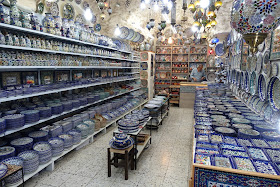We spent about 2.5 days there altogether this time, starting with one early morning when we had a quick walk-through of the Old City. We entered through Herod’s Gate, one of the seven city gates which are accessible from outside and one that led us into the Muslim Quarter in the northeastern part of the city. The Old City Jerusalem is divided into four quarters – Christian Quarter, Jewish Quarter, Muslim Quarter and Armenian Quarter – and historically inhabited by different people of different religious beliefs.
 |
| Church of St Anne |
 |
| The 7th station marks the place where Jesus passed through the Gate of Judgment, and fell for a second time carrying the cross |
We then made our way into the Christian Quarter, following the famous path of Via Dolorosa, or the "Way of Sorrows" to commemorate the route Jesus followed where He was condemned, carried the cross to the Calvary where He was crucified and buried (and resurrected) Traditionally the path was marked by fourteen "stations" which Christian pilgrims have followed for centuries, each marked for an event on the day of crucifixion as described in the Books of Gospel, ending at Church of the Holy Sepulchre, built, destroyed and re-built several times on the site known as the Calvary or Golgotha, which according to The Bible as where Jesus was crucified and buried.
 |
| Church of the Holy Sepulchre |
 |
| Western Wall during Sukkot |
 |
| Herod's Gate |
 |
| Jaffe's Gate |
On the side between Damascus Gate and Jaffe Gate (largely Christian Quarter and part of the Muslim Quarter) is where the busiest streets are. Through those little alleys and side streets one can find everything from clothes, household supplies, souvenirs (a lot of them), meat and seafood, restaurants and cafes, or even barber shops, tailors and antique stores. We made a quick stop at Jafar Sweets for a plate of traditional knafeh, a Middle-eastern dessert made with soft cheese topped with caramelized orange syrup (and a lot of coloring), for that interesting savory and super sweet combination. Did require an acquired taste to enjoy, but worth a try.
(Jafar Sweets: 40 Beit Habad St., Old City Jerusalem)
 |
| Church of All Nations |
 |
| Garden of Gethsemane |
(Touring Middle East - Part 8)
Read the entire series of Touring Middle East:
1. Madaba and Our First Lunch
2. Petra By Night
3. Petra By Day
4. Dining Under Starlight
5. Crossing Jordan and Full Moon by the “Sea”
6. Following the Footsteps
7. Runaway Dinner in Tiberias
8. Old City Jerusalem
9. Walking Around the Local Market
10. Dinner at Chakra
11. Discovery By Accident
12. The Walled Off Bethlehem
13. Italian in Jerusalem
14. Kosher Dinner
1. Madaba and Our First Lunch
2. Petra By Night
3. Petra By Day
4. Dining Under Starlight
5. Crossing Jordan and Full Moon by the “Sea”
6. Following the Footsteps
7. Runaway Dinner in Tiberias
8. Old City Jerusalem
9. Walking Around the Local Market
10. Dinner at Chakra
11. Discovery By Accident
12. The Walled Off Bethlehem
13. Italian in Jerusalem
14. Kosher Dinner











Thank you ! Israel and Jerusalem, the homeland of Jesus and his mother Mary !
ReplyDelete